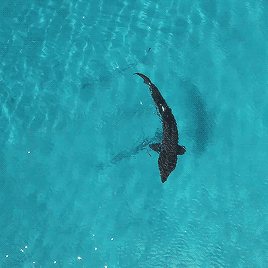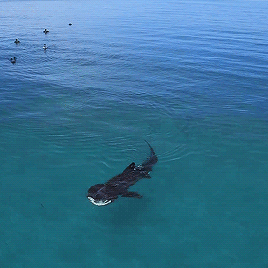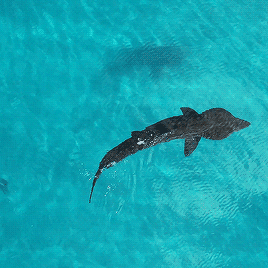Wet Specimen Of A Baiji Calf (Lipotes Vexillifer).

Wet specimen of a baiji calf (Lipotes vexillifer).
The gestation period for this species lasted 10-11 months. Calves measured around 80–90 centimetres (31–35 in) at birth, and nursed for 8–20 months. [x]
More Posts from Rhincodon-cynocephalus and Others
Meet the largest family of living sharks today—deep-sea catsharks.
Deep-sea catsharks are the largest family of living sharks today, with more than 90 species. Catsharks were named for their long, cat-like eyes that are specialized for seeing in low light conditions. These a-meow-zing sharks can be found up to 2,200 meters (7,200 feet) below the surface and grow up to 75 centimeters (30 inches).

MBARI has observed several deep-sea catshark species, for example, the brown catshark (Apristurus brunneus), longnose catshark (Apristurus kampae), lollipop catshark (Cephalurus cephalus), and filetail catshark (Parmaturus xaniurus). Most catsharks lay elaborate clusters of egg cases. The eggs can take up to two years to develop. Tough egg cases, made of keratin protect the developing embryos from predators. A changing ocean means an uncertain future for catsharks. Warming waters could affect developing embryos, and expanding low-oxygen zones could displace adult populations.


𓆰𓅢 𝐁𝐨𝐧𝐞 𝐛𝐥𝐚𝐜𝐤 𝐛𝐞𝐚𝐬𝐭 𓅢𓆰

Illustrated Sketches of Natural History: Consisting of Descriptions and Engravings of Animals. Second Series. 1864.
Internet Archive


11/30/22 California Condor



memento mori enamel pins - little remembrances of death
Quagga with African Daisies
Vaquita with Lost New Mexican Sunflowers
Thylacine with Maiden’s Bush-pea
you can pre-order at greerstothers.shop

Ghost Shark (pointy nosed blue chimera) + Ghost Octopus.
The ancient Egyptians: And they were dualistic counterparts Herman te Velde, writing papers about Set in the 1960s: Oh my god they were dualistic counterparts

The Kingdom of Animals. Written by David Taylor. Illustrated by David Quinn. 1990.




Drone footage of a Basking shark in clear Scottish waters

A Sea Full of Sharks. Written by Betsy Maestro. Illustrated by Giulio Maestro. 1990.
-
 cataradical liked this · 2 months ago
cataradical liked this · 2 months ago -
 narwa liked this · 3 months ago
narwa liked this · 3 months ago -
 wildernestt reblogged this · 1 year ago
wildernestt reblogged this · 1 year ago -
 lost-forest-heart liked this · 2 years ago
lost-forest-heart liked this · 2 years ago -
 the-unknown-friend liked this · 2 years ago
the-unknown-friend liked this · 2 years ago -
 itsalwayssol liked this · 2 years ago
itsalwayssol liked this · 2 years ago -
 liedaniel liked this · 2 years ago
liedaniel liked this · 2 years ago -
 jamesmassino liked this · 2 years ago
jamesmassino liked this · 2 years ago -
 cassyrea reblogged this · 2 years ago
cassyrea reblogged this · 2 years ago -
 gendersfake reblogged this · 2 years ago
gendersfake reblogged this · 2 years ago -
 barnsburntdownnow reblogged this · 2 years ago
barnsburntdownnow reblogged this · 2 years ago -
 rhincodon-cynocephalus reblogged this · 2 years ago
rhincodon-cynocephalus reblogged this · 2 years ago -
 rhincodon-cynocephalus reblogged this · 2 years ago
rhincodon-cynocephalus reblogged this · 2 years ago -
 rhincodon-cynocephalus liked this · 2 years ago
rhincodon-cynocephalus liked this · 2 years ago -
 thylawhiskers reblogged this · 3 years ago
thylawhiskers reblogged this · 3 years ago -
 thylawhiskers liked this · 3 years ago
thylawhiskers liked this · 3 years ago -
 son-of-the-antlered-ones liked this · 3 years ago
son-of-the-antlered-ones liked this · 3 years ago -
 mudcrabmassacre liked this · 3 years ago
mudcrabmassacre liked this · 3 years ago -
 c4n1ne reblogged this · 3 years ago
c4n1ne reblogged this · 3 years ago -
 dimens1ons liked this · 4 years ago
dimens1ons liked this · 4 years ago -
 in-vyn-cible liked this · 4 years ago
in-vyn-cible liked this · 4 years ago -
 utah61 liked this · 4 years ago
utah61 liked this · 4 years ago -
 klomonx2 reblogged this · 4 years ago
klomonx2 reblogged this · 4 years ago -
 nautomic reblogged this · 4 years ago
nautomic reblogged this · 4 years ago -
 neworldiscoverer liked this · 4 years ago
neworldiscoverer liked this · 4 years ago -
 soll-lleks reblogged this · 4 years ago
soll-lleks reblogged this · 4 years ago -
 barnsburntdownnow liked this · 4 years ago
barnsburntdownnow liked this · 4 years ago -
 canineshadowproductions liked this · 4 years ago
canineshadowproductions liked this · 4 years ago -
 deviledeggi reblogged this · 4 years ago
deviledeggi reblogged this · 4 years ago -
 thejojolands-moved liked this · 4 years ago
thejojolands-moved liked this · 4 years ago -
 cultts liked this · 4 years ago
cultts liked this · 4 years ago -
 swore liked this · 4 years ago
swore liked this · 4 years ago -
 they-who-wander liked this · 4 years ago
they-who-wander liked this · 4 years ago -
 itriedtoescape liked this · 4 years ago
itriedtoescape liked this · 4 years ago -
 floppingmackeral liked this · 4 years ago
floppingmackeral liked this · 4 years ago -
 deviledeggi liked this · 5 years ago
deviledeggi liked this · 5 years ago -
 clownspouse liked this · 5 years ago
clownspouse liked this · 5 years ago -
 eve1steve liked this · 5 years ago
eve1steve liked this · 5 years ago -
 crow-king-ash liked this · 5 years ago
crow-king-ash liked this · 5 years ago -
 jupiterprincesshouou liked this · 5 years ago
jupiterprincesshouou liked this · 5 years ago -
 reiddoesrandomshit liked this · 5 years ago
reiddoesrandomshit liked this · 5 years ago -
 g3gee liked this · 5 years ago
g3gee liked this · 5 years ago -
 angel-fallz reblogged this · 5 years ago
angel-fallz reblogged this · 5 years ago -
 angel-fallz liked this · 5 years ago
angel-fallz liked this · 5 years ago -
 strawbebehmod reblogged this · 5 years ago
strawbebehmod reblogged this · 5 years ago -
 straws-old-blog liked this · 5 years ago
straws-old-blog liked this · 5 years ago -
 thomachine liked this · 5 years ago
thomachine liked this · 5 years ago

Thylacine archive blog: @moonlight-wolf-archive
204 posts